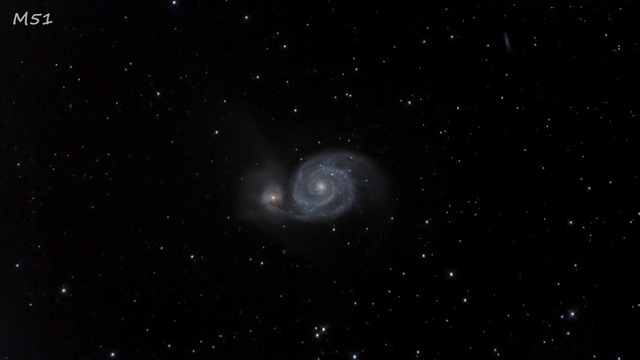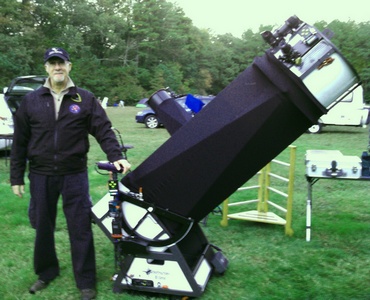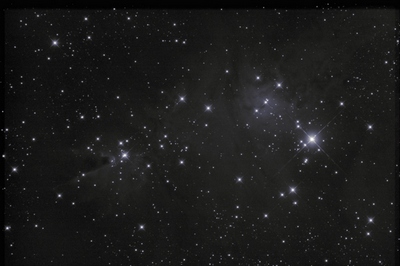 For this past dark window two rewarding observing sessions graced my photon starved eyeball (make that eyeballs for the time I was using binoviewers) bringing to conclusion the longest lasting and most often recurring atrocious observing conditions in one season. Both nights (February 19 and 26) provided a welcome change of long hours of clear sky observing time with seeing and transparency that varied from quite good to below average. The 19th was a dry night of no consequential dew. On the morning of February 20th, I left the Blue Mountain Vista Observing (BMVO) field at 3:13AM at a bearable 37°F. When I arrived for another session at 5:15PM on the 26th it was, again, 37°F but as the night wore on my equipment accumulated a noticeable layer of crusty frost covering all the surfaces. When I left at 4:20AM it was 22°F. What a difference a week and 1 hour makes!
For this past dark window two rewarding observing sessions graced my photon starved eyeball (make that eyeballs for the time I was using binoviewers) bringing to conclusion the longest lasting and most often recurring atrocious observing conditions in one season. Both nights (February 19 and 26) provided a welcome change of long hours of clear sky observing time with seeing and transparency that varied from quite good to below average. The 19th was a dry night of no consequential dew. On the morning of February 20th, I left the Blue Mountain Vista Observing (BMVO) field at 3:13AM at a bearable 37°F. When I arrived for another session at 5:15PM on the 26th it was, again, 37°F but as the night wore on my equipment accumulated a noticeable layer of crusty frost covering all the surfaces. When I left at 4:20AM it was 22°F. What a difference a week and 1 hour makes!
On the 19th there was a nice line-up of Dobsonian telescopes, all with tracking motors and GoTo digital setting circles. All were manned by long-time observing companions anxious to take advantage of the forecasts: Lionel (16” F/4.2), Lou B (17.5” F/4.1), Josh (25” F/4), Robert W (22” F/3.6), John H (18.5” F/4.0) with his Binocular Photon Machine (BIPH [http://nightvisionastronomy.com/]) and Igor who had the only imaging rig present consisting of a 6" AstroTech Ritchey-Chretien astrograph and Canon T3 camera on an Orion Atlas equatorial mount. Skipping ahead to the 26th there was a larger turnout, although Lionel, Igor and John weren’t there, Rob C added his 20” F/5 to the mix, again, with Robert, Josh and Lou, plus several DVAA members that showed with scopes including a 14” Edge HD, 8” SCT, some refractors and other Dobs. The 14” EdgeHD parked beside me, I watched as the owner ramped out a hydraulic lift on wheels to hoist the 14” onto his Celestron CGE-Pro mount. But the lift failed, so both the owner and his son had to wrestle the scope onto the shoulder high mount/saddle accompanied by quite a few audible grunts and huffs as they repeatedly attempted to lock it all down over the next half hour. Lesson: if mechanical assists are necessary for a large “portable” scope, it’s advisable to have a Sherpa on hand.
 An early pre-sunset setup put me in position to spend plenty of time on the Orion Nebula and its nearby neighbor, the Horsehead. The Horsehead, of course, is only visible in sufficiently dark skies with Hydrogen-Beta filtering so that the emission nebula IC434 can deliver the necessary contrast to silhouette the dark Horsehead. It was just barely visible with steady averted vision on each of the two nights. It “paled” to what I recalled seeing in early November when visiting a friend on the eastern shore of the Chesapeake where the Horsehead popped beautifully and easily under the inky black sky there. But I take what I can get after several months of not using my 18” F/4.3 Dob.
An early pre-sunset setup put me in position to spend plenty of time on the Orion Nebula and its nearby neighbor, the Horsehead. The Horsehead, of course, is only visible in sufficiently dark skies with Hydrogen-Beta filtering so that the emission nebula IC434 can deliver the necessary contrast to silhouette the dark Horsehead. It was just barely visible with steady averted vision on each of the two nights. It “paled” to what I recalled seeing in early November when visiting a friend on the eastern shore of the Chesapeake where the Horsehead popped beautifully and easily under the inky black sky there. But I take what I can get after several months of not using my 18” F/4.3 Dob.
The Orion Nebula always delights regardless of conditions, but clearly resolving the E and F stars of the Trapezium was difficult due to the seeing conditions of the early night. When encountering this again on the 2nd night it prompted me to spend time making comparisons in Lou’s 17.5” F/4.1 at similar magnification and those proto stars appeared to be easier catches in his scope, although Josh, whose eyes are 30 years younger than mine, believed the views were exactly the same after he checked out both scopes. Lesson: obsessing over optics can impede quality observing time.
By 9PM I had attained several highlights. Among them were the Pinwheel Galaxy, Cleopatra’s Eye, Thor’s Helmet, Hubble’s Variable Nebula and open cluster M46. Eight hundred light years closer but visually positioned near the center of M46 is planetary nebula NGC2438. I pushed the power somewhat with an OIII filter which fetched a good hint of NGC2438’s annular form but not to the extent seen on other better nights.
By 9:30PM the bright Eskimo Nebula was transiting the meridian at 70° altitude and held up very well at various power levels, all the way up to 904x. Sharing the view with nearby observers from the DVAA brought a few flattering remarks, like, “I haven’t seen that kind of detail except in a photograph.” Robert W had it at 1600+x in his 22”. Stupid power tricks as he calls it… but a fun view nonetheless.
I spent some time with John H at his 18.5” and his BIPH. When using the BIPH John installs a reducer to bring his F ratio to 2.5. He had many pieces of exciting eye candy that kept me and others entertained for some time, such as NGC 4565, NGC 4631 (The Whale), M81, M82, the Leo Triplet and the Cone Nebula. The views were all against a green background just as night vision goggles display and there is video noise in the form of speckling which can be distracting for some but the definition and details that emerged from the unit’s screen were captivating. The BIPH is large enough for glasses wearers and presents a very comfortable “stereo” view. The exercise inspired me to hook up my Binotron 27 binoviewers at my scope so I could do some mental comparisons. I didn’t get, nor did I expect, the same amount of detail, nor brightness that the BIPH exhibits but the green background and speckles were absent. Lesson: everything is a compromise in this hobby.

Igor was imaging the Cone Nebula. He partially processed a black and white image (at left) of 26 x 5 minute sub-frames which was not enough to produce a decent color image. It accompanies this report that Igor said I could share. Lesson: I’m sure there’s a lesson lurking there but I’m not an imager so I don’t know what it is.
At Lou’s scope I saw a superb view of the Ghost of Jupiter (NGC3242) on the night of the 19th, /which is when I noticed that my glasses were missing. Lionel, Josh, John H, Robert W and Igor, all with red lights and later at least one white light, were treading softly looking for my spectacles to no avail. I was going to write them off but the next morning I decided to make a trip back to BMVO in the afternoon. While there with my wife, she found them in about 5 minutes near where Lou was set up. She’s an avid reader of mysteries so she’s well versed in seeking out clues. The glasses’ location was consistent with one of my many musings on how the glasses got lost: when I bent over to read Lou's UTA's cheat sheet of EP magnifications the glasses fell out of my vest pocket. The really surprising thing is that they were intact. Lou's Sienna mini-van and trailer's tires somehow managed to miss running over them. Even Lou's feet missed them while he relentlessly walked back and forth when packing up! Lesson: attach a lanyard to your glasses.
For challenges, on both Sundays, I observed comets 41P Tuttle-Giacobini-Kresak and 45P Honda-Mrkos-Pajdusakova (that looked nice so near to the galaxy NGC 4414). After a fair amount of protracted pondering on each of these diffuse objects I decided to stick with easier targets, like M51 (the Whirlpool Galaxy). I returned to it repeatedly throughout both Sunday nights (Monday mornings) as the galaxy climbed higher by the hour. Each observation uncovered more interesting facets. When the Big Dipper’s handle was just about overhead I gave M51 a final prolonged stab, absorbing all I could. The spirals wound nicely around a small cotton ball core. I don’t think I was imagining the faint outer arm straining to reach out to connect to M51a. That arm seemed very delicate, just mere wisps at best or perhaps my tiring eyes were doing silly observing tricks. Regardless, it was a gratifying, appreciative view of a favorite galaxy. With the help of the thinnest layer of atmosphere M51’s spiral strands of dark and light contrasted well against the black sky for what qualified, to me, to be the View of the Night on both nights. Lesson: get under the clear night sky as often as possible, there’s always a View of the Night to catch.
Clear, dark and steady skies to all.
Fred De Lucia
Thanks go to Igor Peshenko for the gracious loan of his Cone Nebula and M51 photos.




